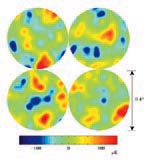DASI data support inflation theory
By Steve KoppesNews Office
 The Degree Angular Scale Interferometer at the South Pole |
The theory, called cosmic inflation, proposes that the universe underwent a gigantic growth spurt in a fraction of a second, moments after the big bang. According to inflation, the largest structures in the universe trace their origins to the fundamental fuzziness of the subatomic world.
 A sample of four false-color maps of intensity variations in the cosmic microwave background from different parts of the sky was created from data collected by the University’s Degree Angular Scale Interferometer. The maps depict tiny deviations, on the order of one hundred thousandth of one degree, in the otherwise uniform 2.73 degree Kelvin background. The maps are a snapshot of the universe as it looked 14 billion years ago. DASI is funded by the National Science Foundation. |
“With these new data, inflation looks very strong,” said John Carlstrom, the S. Chandrasekhar Distinguished Service Professor in Astronomy & Astrophysics. “It’s always been theoretically compelling. Now it’s on very solid experimental ground.”
Carlstrom leads a team of astrophysicists working with the $3 million Degree Angular Scale Interferometer, also known as DASI, at the National Science Foundation’s Center for Astrophysical Research in Antarctica.
The team, which consists of the University’s Nils Halverson, graduate student, Clem Pryke, Research Scientist, Erik Leitch, Research Associate, and John Kovac, graduate student, all in Astronomy & Astrophysics; and colleagues at the California Institute of Technology, University of California, Berkeley, and Caltech’s Jet Propulsion Laboratory, presented its first results from DASI Sunday, April 29, at the American Physical Society meeting in Washington, D.C.
 This power spectrum shows the new result recorded by the University’s Degree Angular Scale Interferometer. DASI records fluctuations in the cosmic microwave background as ripples of different sizes across the sky. The spectrum tells astrophysicists that ripples of certain sizes are stronger than ripples of other sizes. As predicted by inflation theory, the spectrum shows a strong peak at left, a second peak at center and strongly suggests a third peak at right. |
“The thing I find exciting about this field is that you have theoretical models of the entire universe becoming testable,” said Pryke. “You can do an experiment and match up the results against these models.” Twenty years ago, by contrast, experimental technology limited such cosmological theories as inflation strictly to the theoretical domain.
When introduced in the early 1980s, inflation predicted that astronomers should see a pattern of temperature differences in the cosmic microwave background radiation, which pervades the sky. DASI, a highly sensitive interferometer, can measure these subtle temperature variations at an angular resolution of one-tenth of a degree across the sky, about one-fifth of the moon’s angular size.
DASI detects these temperature differences at a time when the universe, now approximately 14 billion years old, was only 400,000 years old. These temperature differences show up in DASI’s data as a ripple pattern that displays as many as three progressively fainter peaks in the blast waves emanating from the big bang.
The inflation model predicts this series of peaks. Two previous experiments have already detected the large first peak, which indicates that the geometry of the universe is flat. This means that light travels in straight lines rather than on curved trajectories.
“DASI sees the first two peaks and strongly suggests a third peak,” Carlstrom said. “If no peaks had shown up, inflation would have difficulties. We’d be back to the drawing board.”
The ratio of the intensity between the first and second peaks tells scientists how much ordinary matter exists in the universe. The DASI data indicate that ordinary matter, the stuff of which humans, stars and galaxies are made, accounts for only 4.5 percent of the universe’s total mass and energy.
Astrophysicists know that eight times as much dark matter exists in the universe.
“The DASI result strengthens the case that most of the mysterious dark matter is comprised of some new form of matter,” said Michael Turner, the Bruce V. and Diana M. Rauner Distinguished Service Professor in Astronomy & Astrophysics and Physics, and Chairman of Astronomy & Astrophysics. “We may be made of star stuff, but we are not made of the stuff of the cosmos.”
The 4.5 percent figure agrees with the estimate of ordinary matter that Turner and David Schramm published in 1998 using a completely different method based on the amount of deuterium produced in the big bang.
Schramm, the Louis Block Distinguished Service Professor in Physical Sciences, who died in 1997, was among the first to realize that deuterium was a sensitive indicator of the density of ordinary matter in the universe.
“The agreement between measures of the amount of ordinary matter is simply stunning,” Turner said. “The underlying physics is completely different. The big bang framework and Einstein’s general relativity have passed a major new test.”
Even though astrophysicists have nearly nailed down the validity of inflation, more work remains.
“This is just the beginning,” Turner said. Further data will come from DASI and its sister instrument, the California Institute of Technology’s Cosmic Background Imager, as well as Chicago’s TopHat experiment and NASA’s Microwave Anisotropy Probe.
“Not only will we be able to test inflation, but we will be able to learn about its underlying physical cause,” Turner said.
![[Chronicle]](/images/small-header.gif)